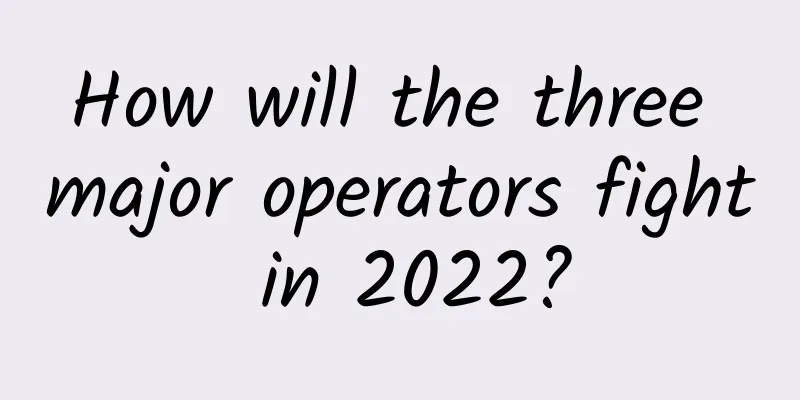How will the three major operators fight in 2022?

|
2022 is here. In this new year, how will the three major operators continue to "fight"? China Telecom and China Mobile have both held their 2022 work meetings, and China Unicom's plans have also become clear. It is actually quite clear what the three major operators will do this year. For example: China Telecom has proposed seven major measures: ① vigorously promote technological innovation and continue to build a technology-based enterprise; ② adhere to customer-centricity and win the new channel of digital economy; ③ accelerate the construction of digital information infrastructure and lay a solid foundation for digital transformation; ④ comprehensively deepen enterprise reform and stimulate the vitality of enterprises; ⑤ enhance the level of enterprise governance and continuously improve the efficiency of enterprise management; ⑥ prevent and resolve various risks and firmly hold the bottom line of no major risks; ⑦ strengthen the overall leadership of the party and effectively enhance the leading and guaranteeing role of party building. China Mobile focuses on eight aspects: ① Laying a solid foundation for transformation and development and building a new type of information infrastructure; ② Deepening scale-based value management and building a new type of information service system; ③ Building a strong technological innovation engine to support high-level self-reliance; ④ Systematically optimizing the management system and continuously improving the company's operating level; ⑤ Deepening the implementation of reforms and accelerating the breakthrough of institutional and mechanism barriers; ⑥ Vigorously improving service quality and creating a competitive advantage in people's hearts and minds; ⑦ Fulfilling the responsibilities and missions of central enterprises and actively integrating into the overall national development; ⑧ Consolidating and deepening the results of party building, and leading and ensuring high-quality development with high-quality party building. In comparison, in fact, in terms of top-level design, the primary strategies of the two major operators are almost the same. Only China Mobile, in combination with its own "defensive position", has specifically proposed the "heart bonus" to strengthen the management of existing customers, while China Telecom and China Unicom are in the "offensive" position and naturally do not need to pay too much attention to existing users. The top-level strategy of the top-level design is one thing, but how to fight on each battlefield is another matter! I tried to combine the current policy environment and market development trends, refer to the views of Celestron's analysis, and make the following predictions on the new changes that the three major operators may face in 2022 from the perspectives of individuals, families, and government and enterprise markets. Prediction 1: The personal market faces the reality of a continued shrinking space for growth, but it also ushers in new possibilities for value-added management.In 2021, driven by the operators' "card slot operation", the scale of individual users resumed growth. According to data released by the Ministry of Industry and Information Technology, as of October 2021, the scale of mobile users nationwide increased by 2.5% year-on-year (this figure was only 0.1% in the same period last year), of which mobile Internet users increased by 5.0% (1.2% in the same period last year). This growth is due to the impact of the epidemic on the one hand, and on the other hand it is due to the fact that operators have gained new space driven by 5G phone upgrades and multi-card slot filling, especially multi-card slot filling, which often takes the form of multiple cards for one household or secondary cards for relatives and friends, allowing number usage to grow rapidly. Although the data results are valid, and we expect that operators will continue this model to acquire new users in 2022, we still need to be wary of the risks of inflated users and value dispersion brought about by this new model. In addition, the dividends of 1.6 billion mobile phone users and 1.4 billion mobile Internet users are indeed reaching their peak, and operators need to face up to the situation of shrinking incremental space. On the existing side, user value management will become even more important. Operators continue to create new benefits through 5G upgrades, contracting, integration and other business methods. At the same time, the concept of the Metaverse continues to ferment, which will increase the possibility of filling more personal application value. Although the actual development of the Metaverse is still in the early stages of the grand concept it has built, the development boom of VR/AR, 3D, etc. driven by it is exactly the content and application source that is urgently needed to be filled in the current 5G package products. The concept craze is driving the market towards maturity. The constantly enriched product content not only improves users' 5G experience, but also effectively stimulates users' willingness to upgrade, forming a virtuous circle of user value management. To this end, operators can gain new space for user value growth beyond scale, and there is still great potential for personal market operations. Prediction 2: The home market will concentrate competition in the direction of DICT, the development of smart IoT will open up new space for connection, and the aging social structure will require more attention to the needs of the elderly.Competition in the home market is no longer limited to broadband and Internet TV services. Operators launched a war for the deep integration of "smart homes" in 2021, with home networking WiFi services, home security services, and home cloud storage becoming standard product features for home customers. The home DICT business represented by "whole house intelligence" has begun to take shape. Operators who have entered the market early have already made profits from market sales, and operators who started later have also begun to implement plans. It is expected that in 2022, the development of home DICT based on "connection + terminal/hardware + content/application" will become more large-scale, and the competition around this business will become more intense. In this trend, there are two new changes worth noting: First, the rise of smart IoT brought about by the mutual promotion and mutual achievement of AIoT and smart home/smart community will bring new connection space for operators in addition to individual users. According to the "China Smart Home Device Market Quarterly Tracking Report" previously released by IDC, the shipment volume of China's smart home device market is expected to reach 230 million units in 2021, a year-on-year increase of 14.6%; it is expected that the shipment volume of China's smart home device market will continue to grow at a compound growth rate of 21.4% in the next five years, and the market shipment volume will be close to 540 million units in 2025. Behind this rapid growth in smart home shipments is the large-scale demand for 5G+ smart IoT, and the number of 5G connections will usher in a breakthrough growth. Second, the demands for health security/smart elderly care caused by the increasing aging of society need to be taken seriously by operators. According to the data of China's seventh census, by the end of 2020, the number of people aged 60 and above in my country reached 264 million, accounting for 18.7%; and according to the forecast of the United Nations Population Fund, this number will rise to 400 million by 2035. This huge number of elderly people will form a new subject of demand for smart home services, and their needs will obviously be more focused on smart elderly care services such as security/health/nursing. Operators need to pay attention to this trend and make arrangements as soon as possible. Prediction three: Driven by the development of the digital economy, the government and enterprise market will usher in a new round of growth, but will inevitably face challenges such as diversified competition and data security.The digital economy continues to develop, especially as the central government and local governments continue to promote the implementation of digital economy and digital transformation policies, the scale of my country's digital economy will continue to increase. According to the "14th Five-Year Plan", by 2025, the added value of my country's core digital economy industries will account for 10% of GDP, up from 7.8% in 2020. Driven by the wave of digital economic development and digital transformation, more demand for digital information technology will emerge. The demand entities range from countries, cities, and industries to enterprises, families, and individuals; the demand directions cover ToG scenarios such as smart cities, digital governments, digital societies, and digital villages, as well as ToB scenarios such as industrial Internet, digital offices, and digital operations; the implementation of demand involves mobile Internet technologies such as 5G and the Internet of Things, while also requiring emerging technologies such as big data, cloud computing, artificial intelligence, and even blockchain. For operators, the growth pattern of government and enterprise business brought about by the digital economy will gradually emerge during the 14th Five-Year Plan period and even longer, with broad prospects and a promising future. In the near future of 2022, we can foresee the following major changes in the government and enterprise market: (1) Driven by the accelerated deployment of operators, 5G application scenarios will be more widely implemented, and the value of network connections will be further demonstrated. Specifically, the 5G customized networks that operators concentrated on deploying in 2021 will show large-scale development in 2022, and the project space represented by "5G + Industrial Internet" will be opened up. The deep integration of "informatization + industrialization" will create more business opportunities. (2) The cloud computing service market continues to flourish, and cloud-network integration is advancing in depth. According to relevant IDC reports, by 2024, 25% of organizations in China will improve business flexibility through edge data and application integration on cloud platforms (achieved through cooperation between cloud and communications service providers); and the cloud market structure has a trend of "slowing growth of leading cloud vendors and rapid growth of up-and-coming companies." For operators who have made preparations for the development of cloud-network integration in the past two years, such as structural adjustments and business process optimization, they will continue to gain new growth momentum from the development of cloud-network integration in 2022 and in the future. (3) The demand for digital transformation by SMEs will form a new blue ocean. As the most important component of market entities, SMEs are on the one hand experiencing a trend of vigorous development due to favorable policies, and on the other hand, driven by factors such as the industry environment, technological development, and fierce competition, they have an objective demand for digital transformation. However, at the same time, they are constrained by factors such as their own scale and funds, and most of them are still in the early stages of transformation exploration. The opportunities left for operators mainly lie in the expansion of value-added applications based on basic connection products, and "small and beautiful" standardized solutions are the recommended direction. At the same time, operators also need to face the diversified challenges brought about by cross-border competition, and they need to have some reserves in the ability to cooperate in the development of application products for SMEs. (4) Data security is also a new opportunity and challenge that operators need to face in 2022. The "Regulations on the Security Protection of Critical Information Infrastructure" and the "Data Security Law" will be implemented from September 1, 2021, and the "Personal Information Protection Law" will be implemented from November 1, 2021. According to IDC's forecast, by 2024, requirements for data privacy, security, placement, use, and disclosure will force 80% of China's large enterprises to reorganize their data governance processes on an independent basis, and data governance, zero trust and privacy computing, cloud and edge security will become rigid needs of enterprises. For operators, this rigid demand will form a market space for security products and is a new opportunity point. However, as large enterprises, operators themselves have clear responsibilities and obligations in the security protection of critical information infrastructure, and they need to continue to pay attention and invest in this. In summary, the market environment faced by operators in 2022 is both complex and has many favorable factors. Generally speaking, opportunities outweigh challenges. I believe that operators can seize opportunities and face challenges, and their performance in 2022 will be even better than the high growth in 2021. The above analysis is quoted from CESI’s analysis, please note this. Next, we will focus on how China Mobile will respond to the challenges posed by the other two major operators in 2022, how to continue its growth momentum in 2021, and how to achieve its own breakthroughs... I believe that China Mobile will achieve new breakthroughs in five aspects: "development scale", "structural adjustment", "scientific and technological innovation capabilities", "operational efficiency", and "system and mechanism". 1. Development scaleAs of the end of October, the total number of China Mobile's mobile business customers has reached 957 million, just one step away from the one billion mark. It is believed that at the beginning of 2022, China Mobile will achieve an operating scale of one billion customers. This is unprecedented in the global communications industry and can be regarded as a monument for China Mobile. However, the customer base has reached one billion, which means that there is indeed no room for growth. China Mobile has only two options left in the basic communications track: one is to go abroad and expand overseas markets; the other is to expand the scope of connections and expand the connection between things. At present, these two options are in China Mobile's planning blueprint. In addition, China Mobile's revenue scale will also achieve new breakthroughs. In the first three quarters of this year, China Mobile's operating performance improved across the board, with operating income reaching 648.6 billion yuan, a year-on-year increase of 12.9%. It is expected that the full-year revenue will exceed 860 billion yuan (unofficial), and net profit will be 87.2 billion yuan, a year-on-year increase of 6.9%. It is expected that the full-year profit will exceed 115 billion yuan (unofficial). Whether in terms of revenue or profit, China Mobile will reach its historical peak in 2021. This is due to the 5G dividend, the improvement of China Mobile's own operating capabilities, and of course the improvement of the overall competitive relationship in the industry. Against this backdrop, development in 2022 will be under greater pressure. How to maintain the current scale of revenue and profit while realizing the preservation and appreciation of state-owned assets when the customer scale and traditional demand have peaked is a big test with two key points: 1. Continue to play the driving role of 5G; 2. Realize diversified income. 2. Structural AdjustmentChina Mobile's current revenue structure still has major risks, mainly reflected in the excessive proportion of mobile business revenue and the shrinking market value of mobile business. Once the mobile business is sluggish due to market saturation or policy impacts and growth is weak, China Mobile as a whole will be seriously dragged down. Of course, in recent years, China Mobile has been working hard to adjust its structure and build a complete business layout and integrated product system for CHBN, making the CHBN business and revenue structure more reasonable, continuously increasing the proportion of revenue from households, government and enterprises, and emerging markets, and accelerating the transformation from a pipeline operator to an information service provider. Judging from the results, the effect can be said to be significant. In the past two years, China Mobile's home business (represented by wired broadband), government business (represented by mobile cloud), and emerging markets (represented by overseas business) have developed rapidly, and their share in the overall revenue has gradually increased. There should be no doubt that what China Mobile needs to do in 2022 is to continue to promote the adjustment and optimization of its business structure and continue to increase the proportion of revenue from households, government and enterprises, and emerging markets. 3. Scientific and technological innovation capabilitiesIf the focus of the first two points is on the word "stability", stable income and stable profits, then how to achieve "progress"? The key lies in the improvement of scientific and technological innovation capabilities. What has been China Mobile's most fatal shortcoming in the past decade? Lack of products. To be more precise, it is the lack of competitive products. Although China Mobile has kept up with almost every trend in the past decade, it has repeatedly failed due to product quality and operational problems. What is the problem? The problem is that China Mobile lacks real scientific and technological innovation capabilities. For example, Fetion died due to outsourcing. In recent years, China Mobile has realized the crux of the problem: it will never be able to form real core competitiveness by relying on outsourcing, cooperation and ecology. In the past two years, China Mobile has made many major arrangements in scientific and technological innovation - for example, it has established several new industrial research institutes to open up connections with the industry; established the "China Mobile Academician Expert Workstation" and the "China Mobile Future Research Institute" to begin research on basic core theories and original technologies; established the "China Mobile Science and Technology Association" to widely carry out dual innovation activities and developer competitions to create an innovative atmosphere within the company. In 2022, a key task for China Mobile is to continue to strengthen the construction of its own innovation chain, continuously enhance its key capabilities in digital fields such as AICDE and blockchain, actively integrate into the overall national scientific and technological innovation, and bravely become the "source of original technology" and the "chain leader" of the modern industrial chain. 4. Operational efficiencyIn addition to product problems, another problem China Mobile has faced over the past decade is that its operational efficiency has declined as the company’s size has increased, and its big enterprise problems have become more and more serious. The first manifestation is that China Mobile's decision-making process is too long, departmental walls are too high, and internal friction is too serious, which directly affects the execution efficiency on the market side. The second manifestation is that China Mobile used to have a silo-style management system of "dividing management by province". Later, a large number of professional companies were gradually established. However, the efficiency of collaboration between these professional companies and provincial companies was low, and the collaboration between professional companies was almost blank. The collaboration between the headquarters and professional companies was almost absent, and they were all replaced by simple and crude KPI management. The third manifestation is that China Mobile's construction and arrangement of its own capabilities are chaotic, with a lot of duplication and repeated construction, which has seriously affected the use and output of its capabilities. China Mobile is like a martial artist who has deep internal strength but cannot display it and may go crazy at any time. Of course, in recent years, China Mobile has also been working on solving these problems, such as promoting a series of reforms including political reform, network reform, cloud reform, home reform, and city reform. The purpose is to streamline internal production processes and production relations to improve operational efficiency. China Mobile's focus in 2022: on the one hand, to continue to advance the pace of deepening reform, truly improve productivity, and demand effectiveness and efficiency from reform; on the other hand, to realize the use and output of internal capabilities, focusing on the construction and operation of the "technology + business + data" smart middle platform. 5. Institutional mechanismsThe system and mechanism are issues that China Mobile can never bypass. It can be said that the system and mechanism are the biggest guarantee for all the achievements made by China Mobile in the past twenty years, but also the biggest limitation for a series of problems encountered by China Mobile in its development. The most prominent contradiction lies in the distribution mechanism. As a state-owned enterprise, China Mobile's total salary is closely linked to the company's economic benefits. It implements dual control, controlling the total salary and controlling the staffing. On the distribution side, due to the long-term lack of a reasonable employee value assessment mechanism, China Mobile still generally follows the principle of equal distribution, and the characteristics of the big pot are still prominent. As the total salary is limited and the distribution mechanism tends to be equal, the key incentives for key talents have become China Mobile's most serious problem in the past. How many elite backbones have been lost in China Mobile in the past ten years?! Currently, China Mobile is making full use of national policies to try to break through the limitations of the system and mechanism. For example, the "Double Hundred Action" and scientific and technological reforms have begun to be implemented in internal professional companies, and the results are gradually beginning to emerge. In 2022, it can be expected that China Mobile should have more new attempts to break through the system and mechanism, such as implementing mixed-ownership reform on a larger level. Reform is the only way for China Mobile. Only by breaking through these layers of restrictions can it attract and retain more scientific and technological innovation talents and absorb high-end leading talents. Only when talents are in place can all the above work be implemented and China Mobile will have real hope! |
>>: Year-end review: Communications industry in 2021
Recommend
How to identify the protocol of an unfamiliar CAN network?
In a CAN network, all nodes share a bus for data ...
TmhHost: Korea CN2/Japan CN2, Softbank/Los Angeles CN2 GIA Double 12 discount season payment from 100 yuan
TmhHost recently launched a Double 12 promotion, ...
6G transmission capacity may be 100 times higher than 5G. 5G is here. How far is 6G?
How long does it take to download a 1G high-defin...
edgeNAT Mid-Autumn Festival Promotion: 20% off for monthly VPS and 30% off for annual VPS, Hong Kong CN2/Korea CN2/US CUVIP optional
edgeNAT has sent out promotions for the Mid-Autum...
Mobile phone roaming has finally become history, what about IoT roaming?
As early as this year's "Two Sessions&qu...
5 Mac software that are so useful that you don't want to share them, each of them is a representative of black technology
[[385059]] I have shared a lot of Windows compute...
The real year of 5G: What it means for cloud technology
We are now in the third year of “The Year of 5G.”...
[Black Friday] CMIVPS: 50% off on all VPS annual payments, 30% off on top-up
CMIVPS has launched its last big promotion this y...
TOTHOST: $1.92/month-1GB/8GB SSD/100M unlimited monthly traffic/Vietnam VPS
TOTHOST is a Vietnamese VPS hosting company estab...
Do you know all the HTTP protocols?
[[390013]] 1. HTTP protocol HyperText Transfer Pr...
About remote procedure call gRPC
If you have been exposed to distributed systems, ...
Wen Yanfeng of SF Express: A two-pronged approach of people and technology to help the technical team better understand business needs
[51CTO.com original article] On December 1st and ...
To prevent 5G from the barrel effect, both Sub-6GHz and millimeter wave are indispensable
The wooden barrel effect is a well-known truth. 5...
Dual stack coexistence guarantees application Chifeng City accelerates the construction and application of IPv6 in e-government external network
[[435282]] Chifeng City's e-government extran...
HostXen offers 50 yuan for new users, 50 yuan for old users who charge 300 yuan, and monthly payment for 6G memory package starts from 70 yuan
HostXen launched its first promotion after the Lu...




![[6.18] Megalayer: Hong Kong CN2 independent server from 400 yuan/month, US cluster server from 888 yuan/month](/upload/images/67cabe85cace8.webp)




